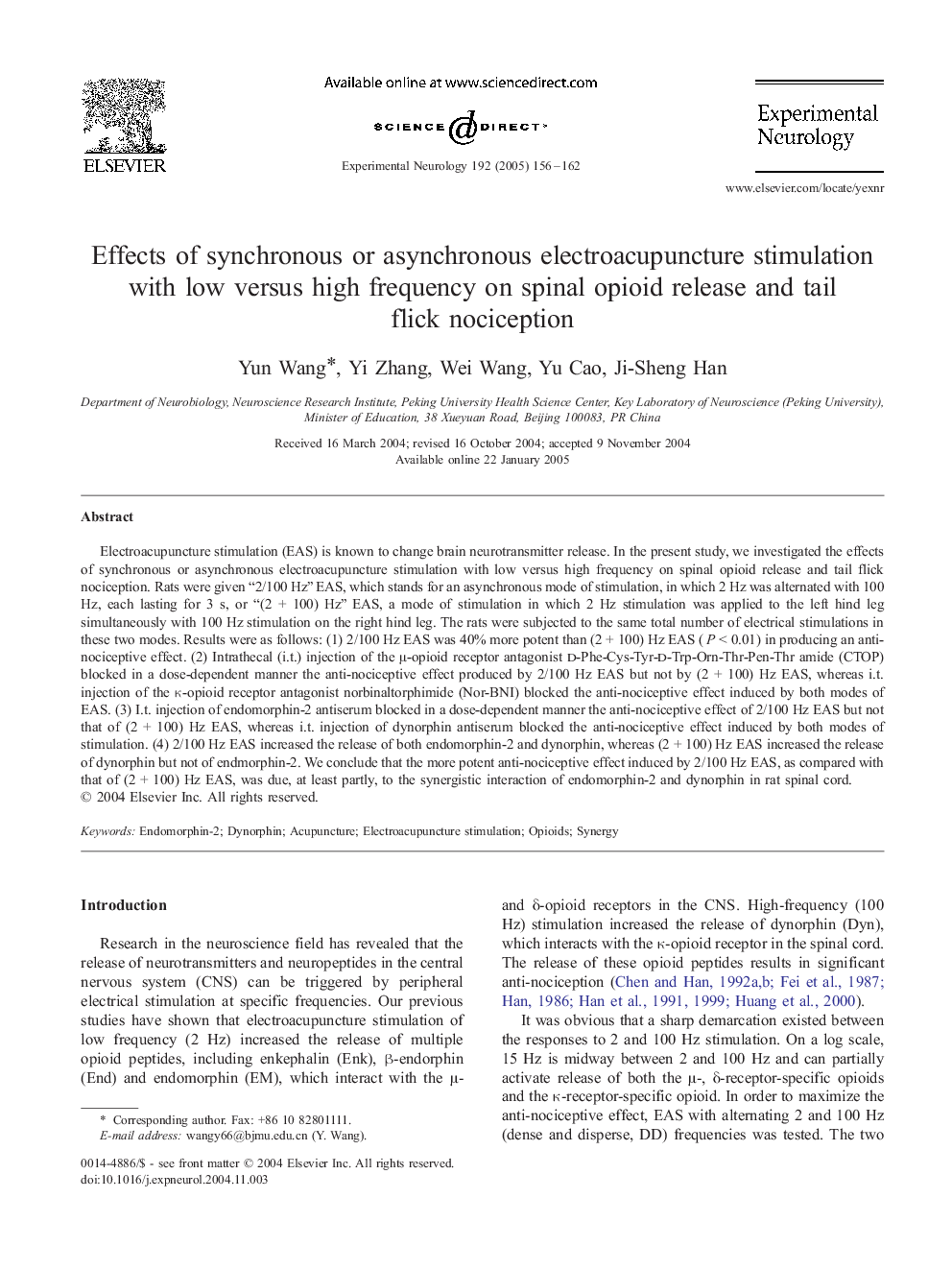| کد مقاله | کد نشریه | سال انتشار | مقاله انگلیسی | نسخه تمام متن |
|---|---|---|---|---|
| 9192089 | 1186613 | 2005 | 7 صفحه PDF | دانلود رایگان |
عنوان انگلیسی مقاله ISI
Effects of synchronous or asynchronous electroacupuncture stimulation with low versus high frequency on spinal opioid release and tail flick nociception
دانلود مقاله + سفارش ترجمه
دانلود مقاله ISI انگلیسی
رایگان برای ایرانیان
کلمات کلیدی
موضوعات مرتبط
علوم زیستی و بیوفناوری
علم عصب شناسی
عصب شناسی
پیش نمایش صفحه اول مقاله

چکیده انگلیسی
Electroacupuncture stimulation (EAS) is known to change brain neurotransmitter release. In the present study, we investigated the effects of synchronous or asynchronous electroacupuncture stimulation with low versus high frequency on spinal opioid release and tail flick nociception. Rats were given “2/100 Hz” EAS, which stands for an asynchronous mode of stimulation, in which 2 Hz was alternated with 100 Hz, each lasting for 3 s, or “(2 + 100) Hz” EAS, a mode of stimulation in which 2 Hz stimulation was applied to the left hind leg simultaneously with 100 Hz stimulation on the right hind leg. The rats were subjected to the same total number of electrical stimulations in these two modes. Results were as follows: (1) 2/100 Hz EAS was 40% more potent than (2 + 100) Hz EAS (P < 0.01) in producing an anti-nociceptive effect. (2) Intrathecal (i.t.) injection of the μ-opioid receptor antagonist d-Phe-Cys-Tyr-d-Trp-Orn-Thr-Pen-Thr amide (CTOP) blocked in a dose-dependent manner the anti-nociceptive effect produced by 2/100 Hz EAS but not by (2 + 100) Hz EAS, whereas i.t. injection of the κ-opioid receptor antagonist norbinaltorphimide (Nor-BNI) blocked the anti-nociceptive effect induced by both modes of EAS. (3) I.t. injection of endomorphin-2 antiserum blocked in a dose-dependent manner the anti-nociceptive effect of 2/100 Hz EAS but not that of (2 + 100) Hz EAS, whereas i.t. injection of dynorphin antiserum blocked the anti-nociceptive effect induced by both modes of stimulation. (4) 2/100 Hz EAS increased the release of both endomorphin-2 and dynorphin, whereas (2 + 100) Hz EAS increased the release of dynorphin but not of endmorphin-2. We conclude that the more potent anti-nociceptive effect induced by 2/100 Hz EAS, as compared with that of (2 + 100) Hz EAS, was due, at least partly, to the synergistic interaction of endomorphin-2 and dynorphin in rat spinal cord.
ناشر
Database: Elsevier - ScienceDirect (ساینس دایرکت)
Journal: Experimental Neurology - Volume 192, Issue 1, March 2005, Pages 156-162
Journal: Experimental Neurology - Volume 192, Issue 1, March 2005, Pages 156-162
نویسندگان
Yun Wang, Yi Zhang, Wei Wang, Yu Cao, Ji-Sheng Han,